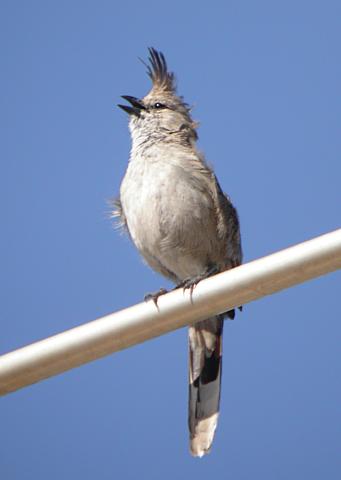Alternative names: Western Wedgebill; Chimes Bird; Wagonbird; Wheelbarrowbird
- Psophodes occidentalis
Identification
19.5 - 22cm.
- Light brown crest (often with black tip) and upperparts
- Light grey underparts with faint streaking on breast
- White edged wing feathers
- Wedge-shaped, black bill
- White-tipped, long tail
Sexes alike. Juveniles are paler and have fluffier plumage.
Similar species
The Chirruping Wedgebill is almost identical and best told apart by voice and distribution.
Distribution
Found in Australia. Range from west-central Western Australia east to southern Northern Territory and northwest and central South Australia.
Common in west of its range, scarce in east.
Taxonomy
This is a monotypic species[1].
Has been considered conspecific with Chirruping Wedgebill and placed in the monotypic genus Sphenostoma.
Habitat
Low shrubs and heath in dry areas.
Behaviour
Very little information about diet. Feeds probably on insects and seeds. Forages on the ground.
Breeding season from January to March and July to September. Its nest is made from twigs, lined with soft dry grass, placed inside a dense clump of vegetation; 2–3 bluish eggs are laid.
Resident species, some local shifts may occur.
References
- Clements, JF. 2008. The Clements Checklist of Birds of the World. 6th ed., with updates to December 2008. Ithaca: Cornell Univ. Press. ISBN 978-0801445019.
- Del Hoyo, J, A Elliott, and D Christie, eds. 2007. Handbook of the Birds of the World. Volume 12: Picathartes to Tits and Chickadees. Barcelona: Lynx Edicions. ISBN 978-8496553422
- Simpson, K and N Day. 1998. Field Guide to the Birds of Australia. London: Christopher Helm. ISBN 0-7136-4877-5
Recommended Citation
- BirdForum Opus contributors. (2024) Chiming Wedgebill. In: BirdForum, the forum for wild birds and birding. Retrieved 4 May 2024 from https://www.birdforum.net/opus/Chiming_Wedgebill





